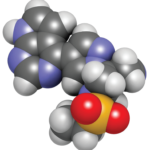Individuals with RA aged 18 years and older in the two databases who filled a new prescription for either tofacitinib or a TNF inhibitor (i.e., adalimumab, certolizumab, etanercept, golimumab or infliximab) during the study period were eligible for inclusion in the observational cohort, but only if they had not received prior treatments with these drugs or biologic DMARDs. Cancer patients or those with a prior venous thromboembolism event were excluded.
Researchers identified a total of 457,171 patients in the two databases who received one of these treatments, and 51,160 of them met all inclusion criteria. Those who were starting treatment with tofacitinib numbered 2,905.
Patients were tracked until treatment discontinuation, switch or insurance disenrollment. Venous thromboembolism was identified based on in-patient claims for pulmonary embolism or deep vein thrombosis. Crude incidence rates of venous thromboembolism in the Truven database were 0.60 per 100 person-years for tofacitinib and 0.34 per 100 person-years in patients receiving TNF inhibitors. These incidence rates were slightly higher in the Medicare database, 1.12 per 100 person-years and 0.92 per 100 person-years, respectively. The authors note that these venous thromboembolism rates are quite low.
“We were very conservative about making causal statements, because this was just an observational, cohort study. The possibility of residual confounding remains a limitation of all database studies,” Dr. Desai says.
“Our understanding of the safety profile of JAK inhibitors is evolving,” he adds. “But this study should provide some reassurance to physicians that the risk of venous thromboembolism in RA [patients] may not be very different for these different categories of treatment. Based on this study, we can rule out a large increase in venous thromboembolism risk for treatment with tofacitinib. It also shows that the overall risk of venous thromboembolism is less than one per 100 person-years. But it’s also important to acknowledge that this is only one potential adverse event in the risk-benefit profile.”
How to Interpret the Data
Mark Genovese, MD, professor of medicine and clinical chief of the Division of Immunology and Rheumatology, Stanford University, California, says rheumatologists have lacked necessary context in which to interpret reported data about venous thromboembolism risk in RA treatment.
“We haven’t fully understood how often venous thromboembolism occurs in RA patients or in the general population, and the potential role for any of these treatments in venous thromboembolism. Work being done, including Dr. Desai’s analysis, is very important in helping to put the problem in more specific relief by asking could these treatments cause more frequent venous thromboembolism events?” he says.




